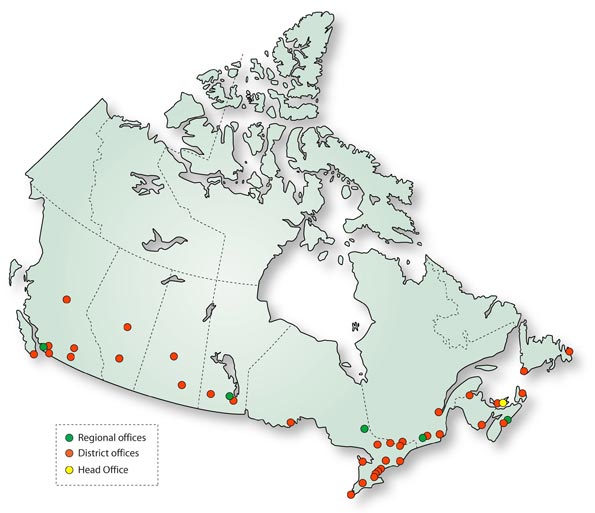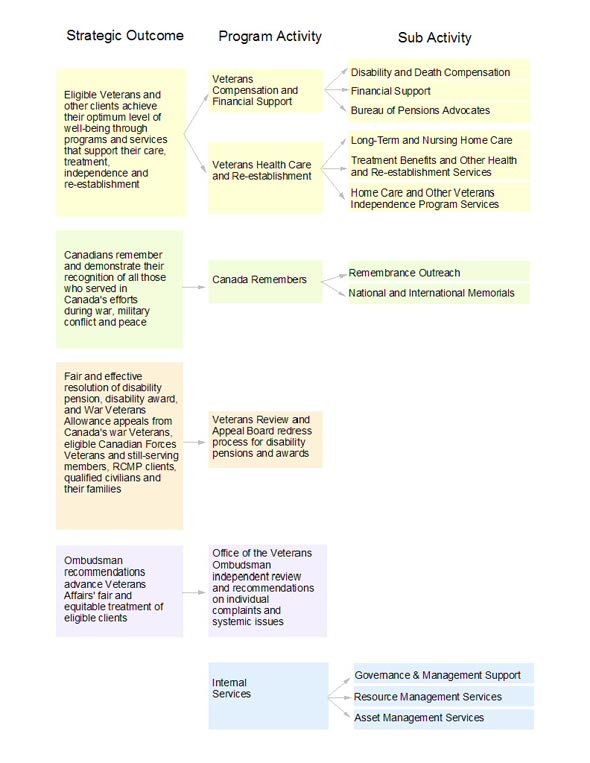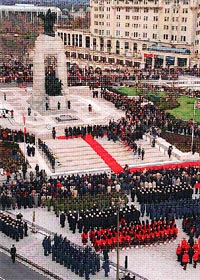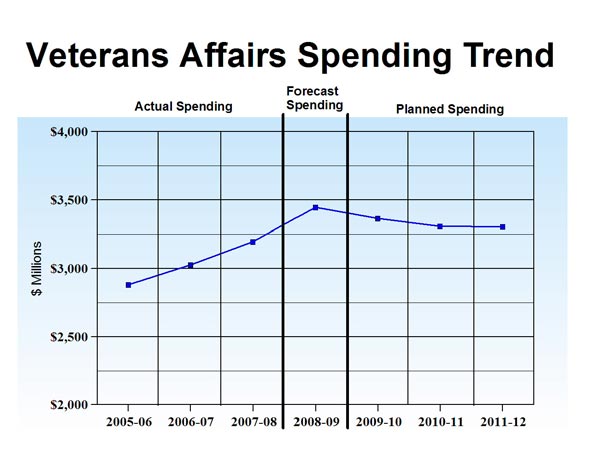Common menu bar links
Breadcrumb Trail
ARCHIVED - Veterans Affairs Canada
 This page has been archived.
This page has been archived.
Archived Content
Information identified as archived on the Web is for reference, research or recordkeeping purposes. It has not been altered or updated after the date of archiving. Web pages that are archived on the Web are not subject to the Government of Canada Web Standards. As per the Communications Policy of the Government of Canada, you can request alternate formats on the "Contact Us" page.
Section I - Overview
Minister's Message

As Minister of Veterans Affairs, it is with great pride that I present our 2009-2010 Report on Plans and Priorities. This report outlines where Veterans Affairs will focus its energies in order to support our commitments to provide client-centred service for the men and women and their families who count on us. We will continue to ensure that anyone who turns to Veterans Affairs Canada for assistance is treated with respect, dignity and fairness.
Given the events that have and are occurring around the world, the men and women of the Canadian Forces are serving in Afghanistan and other areas of conflict in unpredictable and dangerous surroundings. We expect that the number of our Canadian Forces clients will continue to rise in the foreseeable future. In response, Veterans Affairs Canada will continue to improve the services offered under the New Veterans Charter which helps Canadian Forces members, Veterans and their families make a successful transition to civilian life.
Our older Veterans, those who first demonstrated Canada's military prowess to the world, have very different needs. While their number is declining, their need for care is growing. Our commitment to these Veterans and their families is to continue to improve our programs and services.
This year, in order to honour the sacrifices and achievements of our Canadian service men and women, the Department will commemorate the 65th anniversaries of D-Day and the Battle of Normandy, the Italian Campaign and the Liberation of Belgium. While ensuring that the legacy of our war-service Veterans is not forgotten, we will focus on increasing recognition of our Canadian Forces Veterans and in-Canada remembrance activities.
I am proud of Veterans Affairs Canada's staff and their outstanding commitment to our war-service Veterans, Canadian Forces members and Veterans, Royal Canadian Mounted Police clients, and their families. As Canadians, we owe a great debt to our Veterans. We serve them on your behalf, ensuring that their sacrifices and achievements are recognized and honoured.
The Honourable Greg Thompson, P.C., M.P.
Minister of Veterans Affairs
Chair's Message

As Acting Chair of the Veterans Review and Appeal Board, it gives me great pleasure to share with you our plans and priorities for 2009-10. It is a time of transition and change for the Board as we bid farewell to our outgoing Chair of five years, Mr. Victor Marchand, and welcome a new Chair to guide the Board in its service to Veterans.
VRAB provides an independent redress process for Veterans, members of the Canadian Forces and the RCMP, and their families, who are dissatisfied with disability compensation decisions made by Veterans Affairs Canada. In 2009-10, we will continue to transform the way we work to ensure that our program is responsive to our applicants.
Our foremost priority is to hear, determine and deal with applications for reviews and appeals in a fair and expeditious manner. We face many challenges in fulfilling this unique responsibility. That said, we will work hard to improve our processes using new technology and through dialogue with the Bureau of Pensions Advocates and The Royal Canadian Legion.
The Board is also committed to providing the public with accurate information about our processes and performance. We will continue to build on progress made last year in developing tools and strategies to improve communication with our applicants and Canadians.
I look forward to the challenges ahead as we continue to serve our applicants with the highest regard for integrity, impartiality and excellence.
James MacPhee
Acting Chair, Veterans Review and Appeal Board
Raison d'être
Canada's contribution to global peace and security, both as an ally and as a peacekeeping partner, has come at a heavy price to our Veterans. Veterans Affairs exists primarily to repay the nation's debt of gratitude toward those whose legacy is the peace and security we continue to enjoy as Canadians.
Our country's contributions to world peace and security are reflected in the diverse clientele that we serve. In addition to our nation's traditional war Veterans from the First and Second World Wars and the Korean War, our clients include former and serving members of the Canadian Forces (CF), the Royal Canadian Mounted Police (RCMP) and certain civilians as well as eligible family members (survivors and dependants).
Responsibilities
Veterans Affairs is a portfolio consisting of the following organizations: Veterans Affairs Canada (VAC, the Department); the Veterans Review and Appeal Board (VRAB, the Board); and the Office of the Veterans Ombudsman (OVO).
Veterans Affairs Canada
The focus of Veterans Affairs Canada is twofold: providing exemplary, client-centred services and benefits that respond to the needs of our clients, in recognition of their service; and fostering the memory of Veterans.
The Department provides a suite of programs for those suffering from disabilities related to military service.
Under the Pension Act, 163,000 Veterans Affairs and RCMP clients will receive a disability pension in 2009-10, with a projected annual expenditure of $1,744 million. As part of the redress process, the Bureau of Pensions Advocates (BPA) provides free legal advice and representation before the Veterans Review and Appeal Board for clients who are not satisfied with decisions regarding their disability benefits.
The New Veterans Charter (NVC), a client- centric initiative, provides the support that CF Veterans and their families need to ease their transition to civilian life. The comprehensive suite of programs includes rehabilitation, health benefits, job placement assistance, financial support and disability awards. NVC clients do not have to be receiving a disability award to access other programs and services. Including Disability Awards for 4,600 Canadian Forces members and Veterans, the expenditure forecast for the NVC suite of programs is $220 million in 2009-10.
VAC offers three major health care programs: the Veterans Independence Program (VIP); Long-Term Care; and Health Treatment Benefits.
Veterans Independence Program - VIP is a national home care program provided by VAC to help clients remain healthy and independent in their own homes or communities. Complementing other federal, provincial or municipal programs, it meets the needs of clients through providing services such as housekeeping and grounds maintenance, ambulatory health care, transportation, home adaptations, and intermediate nursing home care. Eligible survivors/primary care givers can receive housekeeping and grounds maintenance services. From March 2009 to March 2010, the number of VIP clients is expected to decline by 2 percent to 99,000. Due to increased costs and program usage, expenditures are forecast to increase by 2 percent to $292 million, excluding intermediate nursing care included in long-term care.
Long-Term Care - VAC supports Veterans in long-term care beds, either in a national network of community facilities, in departmental facilities, or in larger contract facilities where Veterans have priority access to beds. Ste. Anne's Hospital, located in Montréal, is the last remaining federal hospital administered by the Department. The total cost of long term care in 2009-10 is expected to be $366 million.
Health Treatment Benefits - VAC's Health Care Program provides Veterans and other eligible clients with treatment and other health-related benefits, including treatment benefits, personalized health care services such as advice and information, needs assessment, advocacy, and referrals. The Health Care Program is designed to enhance the quality of life of clients, promote independence, and assist in keeping clients at home and in their own communities by providing a continuum of care. In 2009-10, approximately 100,000 clients, at an estimated annual cost of $316 million, will benefit from treatment benefits which consist of medical and dental care; surgical or prosthetic aids; prescription drugs and home adaptations; cost of travel to receive benefits; and, treatment allowances paid during periods of acute treatment of a pensioned condition.
Remembrance - VAC fosters the memory of Canada's war dead and Veterans through its remembrance programs. By engaging Canadians, especially youth, the Department keeps alive the achievements and sacrifices made by those who served Canada in times of war, military conflict and peace and promotes an understanding of how they helped shape our country. This year, VAC will send out over 16,000 sample packages of Veterans' Week learning materials (resulting in the distribution of 2.6 million learning and promotional products), financially support more than 150 non-profit groups with commemorative initiatives and cenotaph/monument restoration in Canada, and support local and national remembrance events (in 2008-09, there were over 320 Veterans' Week events across Canada, with tens of thousands of people attending the National Remembrance Day ceremony in Ottawa while two million viewers watched it on television). Internationally, VAC projects one million visitors to the Vimy Ridge and Beaumont-Hamel Newfoundland Memorial National Historic Sites, with two million visitors overall to VAC sites in Europe (including the newly acquired Canada Memorial in Green Park, London, England).
Veterans Review and Appeal Board
The Veterans Review and Appeal Board (VRAB) is an independent quasi-judicial tribunal that operates at arm's length from Veterans Affairs Canada. It has full and exclusive jurisdiction, at the request of individual applicants, to hear appeals of disability compensation decisions made by the Minister of Veterans Affairs.
The Board's objective is to ensure that Veterans, Canadian Forces personnel, Royal Canadian Mounted Police members, certain civilians, and/or their respective dependants receive the disability benefits to which they are entitled under the law. The Board provides two levels of redress for dissatisfied applicants and is the final level of appeal for War Veterans Allowance decisions. The Board is committed to upholding the values of impartiality, excellence, integrity and respect in its day-to-day activities as it delivers an effective and independent redress program.
Veterans Ombudsman
The Office of the Veterans Ombudsman plays an important role in raising awareness of the needs and concerns of our Veterans. The Ombudsman provides them with an opportunity to bring their issues to the attention of the Department. The Ombudsman can raise issues on departmental processes and regulations when he deems structural or regulatory changes are necessary to better meet client needs, and can raise issues concerning individual client cases that are subject to the departmental appeal process (excluding those appealable to VRAB). In addition, the Ombudsman assists Canada's Veterans by providing them with information on the Department's programs and services. The Ombudsman submits an annual report to the Minister who tables it in Parliament.
Veterans Affairs Offices

Charlottetown PE
Western Region
Vancouver BC
Winnipeg, MB
District Offices
Victoria, BC
Vancouver, BC
Prince George, BC
Surrey, BC
Kelowna, BC
Penticton, BC
Calgary, AB
Edmonton, AB
Regina, SK
Saskatoon, SK
Brandon, MB
Winnipeg, MB
Ontario Region
Kirkland Lake, ON
District Offices
Brampton-
Mississauga, ON
Hamilton, ON
Kingston, ON
London, ON
North Bay, ON
Ottawa, ON
Owen Sound, ON
Pembroke, ON
Peterborough, ON
Scarborough, ON
Thunder Bay, ON
Sunnybrook, ON
Windsor, ON
Quebec Region
Montreal, QC
District Offices
Gatineau, QC
Montreal, QC
Sherbrooke, QC
Quebec, QC
Atlantic Region
Dartmouth, NS
District Offices
Saint John, NB
Campbellton, NB
Charlottetown, PE
St. John's, NL
Corner Brook, NL
Halifax, NS
Sydney, NS
Program Activity Architecture

Planning Summary
Planned Spending and Human Resources for Veterans Affairs
| 2009-2010 | 2010-2011 | 2011-2012 | |
|---|---|---|---|
| Veterans Affairs Canada | 3,347.1 | 3,292.0 | 3,287.8 |
| Veterans Review and Appeal Board | 11.2 | 11.2 | 11.2 |
| Office of the Veterans Ombudsman | 5.8 | 5.8 | 5.8 |
| 2009-2010 | 2010-2011 | 2011-2012 | |
|---|---|---|---|
| Veterans Affairs Canada | 3,688 | 3,664 | 3,660 |
| Veterans Review and Appeal Board | 121 | 121 | 121 |
| Office of the Veterans Ombudsman | 40 | 40 | 40 |
| Performance Indicators | Targets | Date to Achieve Targets |
|---|---|---|
| Percentage of clients who report satisfaction with the programs and services offered by Veterans Affairs Canada (measured every two years) | 85% | March 31, 2010 |
| Percentage of War-service clients who were assessed in the last year and who either have maintained or improved their overall health status | 75% | March 31, 2010 |
| Percentage of Canadian Forces clients participating in New Veterans Charter programs who report improved overall health status | To be established | March 31, 2011 |
| Program Activity | Forecast Spending 2009-10 |
Planned Spending | Alignment to Government of Canada Outcomes | ||
|---|---|---|---|---|---|
| 2010-2011 | 2011-2012 | 2012-2013 | |||
| Veterans Compensation and Financial Support | 2,170.7 | 2,057.1 | 2,006.9 | 2,003.9 | Income Security and Employment for Canadians |
| Veterans Health Care and Re-establishment | 1,120.5 | 1,162.7 | 1,157.9 | 1,157.0 | Healthy Canadians |
| Performance Indicators | Targets | Date to Achieve Targets |
|---|---|---|
| Percentage of Canadians engaged in remembrance | 15% | March 31, 2010 |
| Program Activity | Forecast Spending 2008-09 |
Planned Spending | Alignment to Government of Canada Outcomes | ||
|---|---|---|---|---|---|
| 2009-2010 | 2010-2011 | 2011-2012 | |||
| Canada Remembers | 48.2 | 44.8 | 44.8 | 44.8 | A Vibrant Canadian Culture and Heritage |
| Performance Indicators | Targets | Date to Achieve Targets |
|---|---|---|
| Percentage of client concerns that are effectively responded to | 80% of complaints are responded to within 60 days | March 31, 2010 |
| Program Activity | Forecast Spending 2008-09 |
Planned Spending | Alignment to Government of Canada Outcomes | ||
|---|---|---|---|---|---|
| 2009-2010 | 2010-2011 | 2011-2012 | |||
| Veterans Review and Appeal Board redress process for disability pensions and awards | 13.6 | 11.2 | 11.2 | 11.2 | Income Security and Employment for Canadians |
| Performance Indicators | Targets | Date to Achieve Targets |
|---|---|---|
| Percentage of cases and issues resolved through facilitation, observations and recommendations | 100% | March 31, 2010 |
| Percentage of clients who express confidence that OVO is working on their behalf | 85% | March 31, 2010 |
| Program Activity | Forecast Spending 2008-09 |
Planned Spending | Alignment to Government of Canada Outcomes | ||
|---|---|---|---|---|---|
| 2009-2010 | 2010-2011 | 2011-2012 | |||
| Office of the Veterans Ombudsman independent review and recommendations on individual complaints and systemic issues | 5.8 | 5.8 | 5.8 | 5.8 | Income Security and Employment for Canadians |
| Program Activity | Forecast Spending 2008-09 |
Planned Spending | ||
|---|---|---|---|---|
| 2009-2010 | 2010-2011 | 2011-2012 | ||
| Internal Services | 88.5 | 82.5 | 82.4 | 82.1 |
Contribution of Priorities to Strategic Outcomes
Veterans Affairs has:
- four strategic outcomes (two for Veterans Affairs Canada, one for the Veterans Review and Appeal Board, and one for the Office of the Veterans Ombudsman);
- six Program Activities; and
- eight priorities.
| Operational Priorities | Type | Links to Strategic Outcome(s) | Description |
|---|---|---|---|
| Enhancing and adapting programs and services to meet the needs of our Veterans, serving members, other clients and their families (VAC) | Ongoing | Strategic Outcome: Eligible Veterans and other clients achieve their optimum level of well-being through programs and services that support their care, treatment, independence, and re-establishment Program Activities: Veterans Compensation and Financial Support Veterans Health Care and Re-establishment |
Why is this a priority? Our programs and services must adapt to meet the ever-changing and diverse needs of our clients. Plans for meeting the priority
|
| Implementing a Mental Health Strategy to enhance capacity to meet the mental health needs of clients (VAC) | Ongoing | Strategic Outcome: Eligible Veterans and other clients achieve their optimum level of well-being through programs and services that support their care, treatment, independence, and re-establishment Program Activities: Veterans Health Care and Re-establishment |
Why is this a priority? With an increasing prevalence of psychological and psychiatric-related conditions, supporting clients and their families (with the services that they require, as close to their local community as possible) will help them live satisfying, hopeful and productive lives. Plans for meeting the priority
|
| Engaging Canadians in community-based remembrance activities with an emphasis on Canada's youth (VAC) | Ongoing | Strategic Outcome: Canadians remember and demonstrate their recognition of all those who served in Canada's efforts during war, military conflict and peace Program Activity: Canada Remembers |
Why is this a priority? War-service Veterans are a direct link to our history. We must honour them, mark the passing of an era, and preserve their legacy. Equally, we also recognize and honour our Canadian Forces Veterans. Plans for meeting the priority
|
| Sustained program (VRAB) | Previously committed to | Strategic Outcome: Fair and effective resolution of disability pension, disability award, and War Veterans Allowance appeals from Canada's war Veterans, eligible Canadian Forces Veterans and still-serving members, RCMP clients, qualified civilians and their families Program Activity: Veterans Review and Appeal Board redress process for disability pensions and awards |
Why is this a priority? It ensures applicants have an avenue of redress by an independent tribunal for disability compensation and War Veterans Allowance claims. Plans for meeting the priority
|
| Improved program delivery (VRAB) | Ongoing | Strategic Outcome: Fair and effective resolution of disability pension, disability award, and War Veterans Allowance appeals from Canada's war Veterans, eligible Canadian Forces Veterans and still-serving members, RCMP clients, qualified civilians and their families Program Activity: Veterans Review and Appeal Board redress process for disability pensions and awards |
Why is this a priority? Enhancing program delivery through innovation and use of technology improves the process for applicants. Plans for meeting the priority
|
| Engaged communication with appellants and stakeholders (VRAB) | Ongoing | Strategic Outcome: Fair and effective resolution of disability pension, disability award, and War Veterans Allowance appeals from Canada's war Veterans, eligible Canadian Forces Veterans and still-serving members, RCMP clients, qualified civilians and their families Program Activity: Veterans Review and Appeal Board redress process for disability pensions and awards |
Why is this a priority? It ensures applicants and all Canadians have information on the Board's mandate, program, and redress process, while meeting the increasing information needs of applicants. Plans for meeting the priority
|
| Ensuring the fair treatment of the Veteran community and upholding the rights articulated in the Veterans Bill of Rights (OVO) | New | Strategic Outcome: Ombudsman recommendations advance Veterans Affairs' fair and equitable treatment of eligible clients Program Activity: Office of the Veterans Ombudsman independent review and recommendations on individual complaints and systemic issues |
Why is this a priority? The sacrifices of our Veterans are recognized through the equitable, fair, accessible and timely provision of services, benefits and support. An independent voice is essential in ensuring that commitments are honoured. Plans for meeting the priority
|
| Enhancing organizational effectiveness (VAC) | Ongoing | Strategic Outcome: Links to all Strategic Outcomes Program Activity: Internal Services |
Why is this a priority? Efficiencies and improved internal functions and processes support a workforce that will provide the best possible service to our clients and their families. Plans for meeting the priority
|
National Memorials in Ottawa

- Tomb of the Unknown Soldier, Confederation Square
- National War Memorial, Confederation Square
- Memorial Chamber, Peace Tower, Parliament Buildings
- Nursing Sisters Memorial, Hall of Honour, Centre Block, Parliament Buildings
- Monument to Canadian Fallen (Korean War), MacKenzie King Bridge
- Memorial Arch, East and West Memorial Buildings, Wellington Street
- Canadian Peacekeeping Memorial, Sussex Drive
- National Aboriginal Veterans Monument, Confederation Park
- Commonwealth Air Forces Ottawa Memorial, Green Island
- Ottawa Cremation Memorial, Beechwood Cemetery
Risk Analysis
Operating Environment
Veterans Affairs Canada's programs are delivered through a network of more than 40 offices throughout the country and overseas. The Veterans Review and Appeal Board holds hearings in Charlottetown and across the country and the Veterans Ombudsman has offices in Charlottetown and Ottawa. To provide these services, the Portfolio has approximately 4,200 full and part-time employees with planned spending for 2009-10 of just under $3.4 billion.
Client Environment
The estimated total War-service Veteran population will decline from 176,000 to 156,000 in 2009-10 and then to 118,000 in 2011-12, of which 47.5 percent will be VAC clients.
The number of Canadian Forces members serving in peacekeeping and peacemaking missions and other international operations has significantly expanded in recent years. This increase in operational tempo has directly resulted in more operational stress injuries and a corresponding need for higher levels of support from VAC and DND for CF members and families. Although the total Canadian Forces Veteran population of 593,000 in 2011-12 is expected to remain virtually unchanged from 2009-10, the number of our CF clients is expected to increase from 56,000 in April 2009 to 64,000 in March 2012 (11 percent of the CF Veteran population).
The RCMP also continues to face many challenges, while dealing with the inherent danger, risks and stresses of policing. The number of disability pensions and associated benefits provided by VAC to RCMP members continues to increase.
The demand for and intensity of care required to support aging War-service Veterans (average age of 87 in 2009-10) and their spouses continues to rise. In addition to this demand, the increased program demands and service delivery expectations of Canadian Forces members and families are sometimes very different to those of the War-service Veterans. These issues make the operating environment much more complex, which continues to place additional pressure on operating performance as both VAC and VRAB strive to serve our clients.
A significant component of the Department's programming is Ste. Anne's Hospital, our only remaining long-term care facility. It provides long-term care and day support services to Veterans while also providing specialized mental health services to CF members and Veterans. Renovations of the hospital to enhance the quality of life of the Veterans are expected to be completed in early 2010.
Government Context
The core economic priorities of the Government of Canada include reforming global finance, ensuring sound budgeting, securing jobs for families, expanding investment and trade, and making government more effective. In addition, the Government will work to secure our energy future, tackle climate change and preserve Canada's environment, contribute to global security, and build stronger institutions.
In order to secure an effective Public Service, the Clerk of the Privy Council has four public service-wide priority areas for Public Service Renewal: Planning, Recruitment, Employee Development and Enabling Infrastructure.
VAC's priorities, policies, programs and services are aligned with the priorities of both the Government of Canada and the Clerk of the Privy Council. Specifically, through activities such as its Integrated Human Resources and Business Planning, Veterans Affairs advances the Government's public service renewal initiatives and supports the economic priorities of ensuring sound budgeting and making government more effective. In addition, Veterans Affairs contributes to the Government priority of global security through programs and services that support Canadian Forces members and Veterans and their families, and former and serving members of the RCMP.
Partnerships
Partnerships are fundamental to VAC's service delivery as it strives to provide services to clients closer to where they reside and as such, we liaise with other federal departments whose mandates link closely to its own. VAC and DND work together to provide a seamless transition for releasing CF members and their families. Through the Federal Healthcare Partnership (FHP), VAC and six federal partners collaborate to identify, promote and implement more efficient and effective health care programs, providing strategic leadership and maintaining healthcare service levels while achieving economies of scale. The Department also works with Provincial, Territorial, and Regional Health Authorities to address our clients' needs, as well as communicating on a regular basis with stakeholder organizations who advocate on behalf of their members for improved health, social, home and long-term care services.
Partnerships and collaborations with other government departments, stakeholders and Veterans' Organizations are crucial to the delivery of remembrance programming. Through the Partnership Contribution Program, VAC financially assists non-profit groups with commemorative initiatives and cenotaph/monument restoration. The Department continues to increase its reach to Canadians by integrating remembrance with non-traditional activities.
Risks and challenges
The major risks associated with the delivery of our programs can be grouped under four headings: Client Needs and Demographics; Service Decisions; Resource Levels; and Contracted Partner Service Delivery.
Client Needs and Demographics
Facing a major demographic shifting client base, constantly changing and diverse needs of client groups, and the inevitable loss of corporate knowledge as key employees retire, our challenge is to ensure the Portfolio's programs and services remain relevant and meet the needs of our clients. We are meeting this challenge through integrated human resources planning, managers becoming more involved in planning of new or revised programs, developing tools to gather staff demographic information, undertaking outreach activities and encouraging knowledge transfer both within and outside the Portfolio. In order to ensure quality and timely service to our CF clients, we need to continue to work closely with DND to improve information sharing and joint delivery of services.
Service Decisions
Due to the associated changes in business processes and systems, the increasing needs and demands of clients are expected to introduce higher levels of risk. In addition to this, changing expectations of Canadians and the need for a greater degree of visibility and accountability can be challenging in a service delivery culture. We are responding by: anticipating needs; keeping staff informed and involved in evolving files; conducting environmental scanning; training and coaching staff; and continuing to improve our service-delivery processes. Another part of our response to these challenges is the role that the Veterans Ombudsman plays in identifying and eliminating barriers to services, support and benefits for Veterans.
Resource levels
The Portfolio must carry out its strategies around recruitment, human resources planning, learning and training so that it can fulfil its mandate to serve our clients whilst continuing to meet Government of Canada initiatives and legislative requirements. Recruitment of sufficient numbers of highly- skilled employees may be difficult given the current labour market and the amount of specialized training required. The Portfolio must compete with other levels of government and the private sector, especially in the occupations of: registered nurses; managers in public administration; and health, education, social and community services professionals. We are managing these risks by collaborating with educators and learning institutions to recruit qualified candidates, establishing pre-qualified pools, and cross-training of existing staff. In addition, the FHP's new Office of Health Human Resources will serve as a central coordination point among the partners' organizations for the recruitment and retention of health care professionals.
VRAB has made progress in reducing the volume of claims pending a hearing and is facing fluctuations in registration of new claims. With fewer cases in some hearing locations, the Board will need to adjust its scheduling process to continue to offer hearings at a similar frequency in the hearing locations. The Board's financial resources and ability to maintain a full cadre of trained members and employees will affect its ability to schedule, adjudicate and finalize claims within the time frames expected by applicants. Competing priorities to implement improvements must be evaluated to ensure that applicants continue to have full access to the redress program.
Contracted partner service delivery
The Department can incur some risks in areas related to privacy breaches by partners and failure to have contracts in place on time and/or not fulfilled. The Department is managing these risks (low likelihood of occurring but high impact should they happen) by having a mandatory review of contracts, engaging information management in all major projects, negotiating for inclusion of e-records standards, exercising effective contract monitoring processes, using contractors who have a history of good contract delivery, maintaining proactive communication and active follow-up. In particular, VAC needs to ensure that a new contract for the Federal Health Care Processing System (used by VAC, RCMP, and DND) is in place in 2012. This system, which provides health claims processing and related services, must take into account the challenges of the collection, maintenance and interoperability of electronic health information..
Expenditure Profile

| $ millions | 2005-2006 | 2006-2007 | 2007-2008 | 2008-2009 | 2009-2010 | 2010-2011 | 2011-2012 |
|---|---|---|---|---|---|---|---|
| Actual | Actual | Actual | Forecast | Planned | Planned | Planned | |
| Totals | 2,881.4 | 3,028.0 | 3,196.5 | 3,447.3 | 3,364.1 | 3,309.0 | 3,304.8 |
The Veterans Affairs spending trend shows actual and forecast expenditure increases through the 2008-09 year. These increases relate to several factors including: implementation and gradual uptake of programs under the New Veterans Charter; annual price indexation adjustments for Disability Pensions; program enhancements under the Veterans Independence Program; ex-gratia payments related to the use of Agent Orange at CFB Gagetown; and additional funding provided through Budget 2007 for enhanced services to Veterans, the establishment of 5 additional Operational Stress Injury clinics and the establishment of the Office of the Veterans Ombudsman.
Expenditures in the three planning years through 2011-12 are expected to show a gradual decline due to a decrease in the number of War Veteran clients accessing Disability Pension and Treatment Benefit programs, and the completion of ex-gratia payments related to the testing of Agent Orange at CFB Gagetown.
Voted and Statutory Items Displayed in Main Estimates
| Vote # or Statutory Item (S) | Truncated Vote or Statutory Wording | 2008-2009 Main Estimates |
2009-2010 Main Estimates |
|---|---|---|---|
| 1 | Veterans Affairs - Operating expenditures* | 970.5 | 939.4 |
| 5 | Veterans Affairs - Capital expenditures | 22.9 | 11.1 |
| 10 | Veterans Affairs - Grants and contributions | 2,353.7 | 2,364.3 |
| 15 | Veterans Affairs - Veterans Review and Appeal Board - Operating expenditures | 9.6 | 9.7 |
| (S) | Contributions to employee benefit plans | 40.7 | 39.3 |
| (S) | Minister of Veterans Affairs' Salary and motor car allowance | 0.1 | 0.1 |
| (S) | Veterans Insurance Actuarial Liability Adjustment | 0.2 | 0.2 |
| (S) | Repayments under section 15 of the War Service Grants Act of compensating adjustments made in accordance with the terms of the Veterans' Land Act | - | - |
| (S) | Returned Soldiers Insurance Actuarial Liability Adjustment | - | - |
| (S) | Re-Establishment Credits under Section 8 of the War Service Grants Act | - | - |
| Total Portfolio | 3,397.7 | 3,364.1 | |
The 2009-10 Main Estimates are $3,364.1 million, a net decrease of $33.6 million from 2008-09.
The major changes are as follows:
- a decrease of $38.9 million in ex-gratia payments related to the use of Agent Orange at CFB Gagetown;
- a decrease of $18.4 million in funding for programs under the New Veterans Charter based on estimated client numbers and average costs per client;
- a decrease of $12.3 million in funding for Disability Pensions and Allowances due to a decrease in the number of war-service Veteran clients;
- a decrease of $11.8 million in capital funding for the Ste. Anne's Hospital Renovation Project based on the current project schedule and the estimated completion during 2009-10;
- an increase of $39.8 million in the Veterans Independence Program due to increased costs and program usage as well as the provision of housekeeping and grounds maintenance benefits to low income or disabled survivors; and
- an increase of $9.1 million in health related benefits due to increased usage as clients age.
